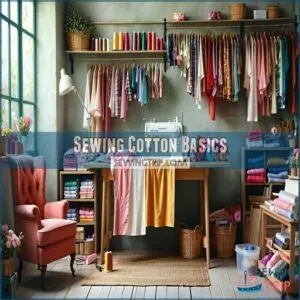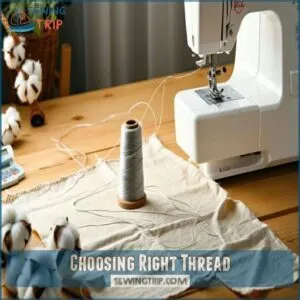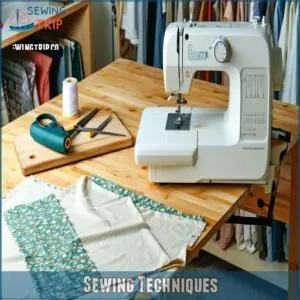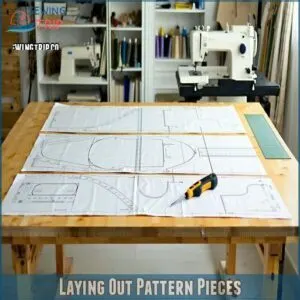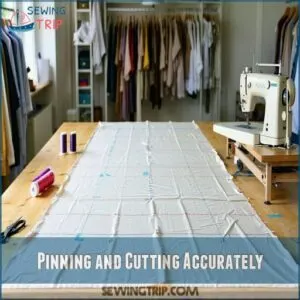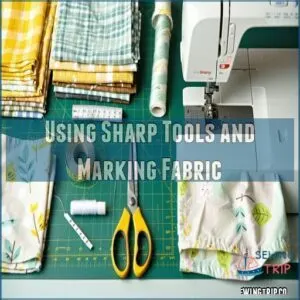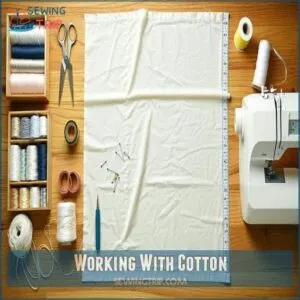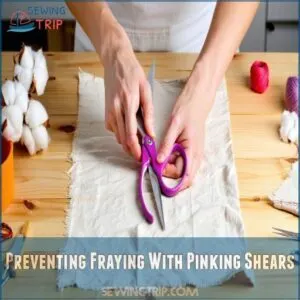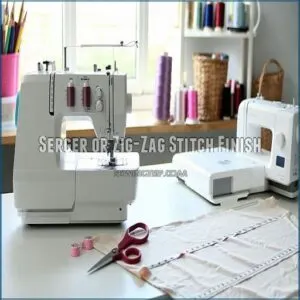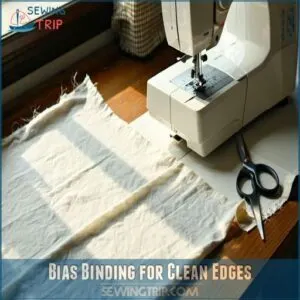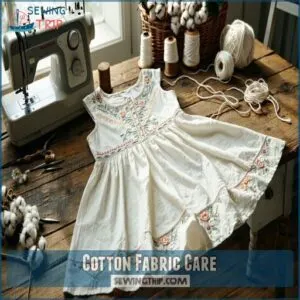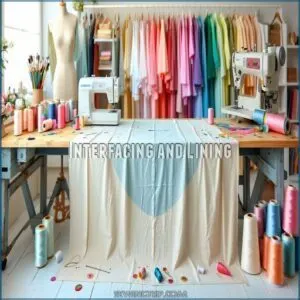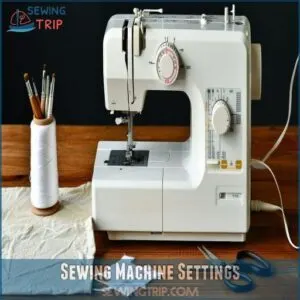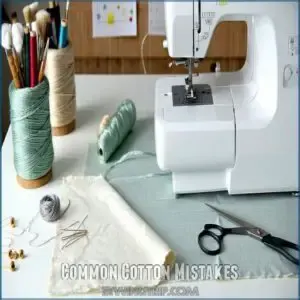This site is supported by our readers. We may earn a commission, at no cost to you, if you purchase through links.
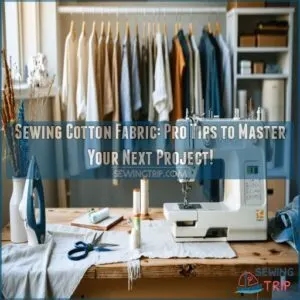
Choose your fabric weight wisely – lightweight for breezy blouses, heavyweight for sturdy projects.
Sharp scissors are your best friends; they’ll slice through cotton like a hot knife through butter.
Don’t skimp on pressing – those crisp seams scream professional quality. When sewing, match your needle and thread to the fabric’s weight, and keep your machine tension just right.
Pro tip: French seams are your secret weapon for a clean, polished finish. Master these sewing cotton fabric advice tricks, and you’ll be turning heads with your impeccable creations.
Table Of Contents
Key Takeaways
- Prewash your cotton fabric before sewing to prevent unexpected shrinkage and color bleeding, ensuring your final project maintains its original size and appearance.
- Choose the right tools and techniques, like sharp fabric scissors, appropriate needle sizes, and matching thread weight, to guarantee professional-looking seams and a polished finish.
- Master seam finishing techniques such as French seams, pinking shears, or zigzag stitches to prevent fraying and add durability to your cotton fabric projects.
- Pay attention to fabric weight, thread tension, and machine settings, adjusting your approach for lightweight, medium, and heavyweight cotton to achieve the best possible results in your cotton fabric sewing.
Sewing Cotton Basics
Ready to transform your cotton sewing projects from amateur to professional?
Whether you’re a beginner or looking to refine your sewing skills, mastering cotton fabric basics will help you create stunning garments with confidence and precision.
Types of Cotton Fabric
Ready to discover the fabric world? Cotton isn’t just cotton – it’s a playground of textures and possibilities.
From airy lawn to rugged denim, each cotton fabric type brings its own swagger to your sewing project.
Lightweight, mediumweight, or heavyweight, these cotton fabrics are waiting to transform your creative vision.
Your fabric choice is your first superpower.
Thread Count and Weight
After exploring cotton fabric varieties, zoom in on the fabric’s DNA: thread count and weight. These hidden textile superheroes determine your project’s success.
Consider these game-changing factors:
- Fabric density shapes your textile’s personality
- Thread thickness impacts overall performance
- Weave types define strength and durability
- Yarn weight influences fabric behavior
Understanding these elements transforms you from amateur to cotton-sewing maestro, giving you the power to choose fabrics that sing with potential.
Preparing Fabric for Sewing
Thread count mastered? Time to level up your cotton fabric game! Prewashing is your secret weapon against fabric rebellion.
Check out this quick prep guide to ensure your fabric is sew-ready:
Understanding fabric glue techniques can also enhance your sewing skills.
| Step | Action | Pro Tip |
|---|---|---|
| 1 | Swatch Test | Check color bleeding |
| 2 | Wash | Prevent future shrinkage |
| 3 | Press | Eliminate stubborn wrinkles |
| 4 | Inspect | Confirm fabric perfection |
Grab your scissors and measuring tape – your fabric’s about to get sew-ready!
Choosing Right Thread
Choosing the right thread can make or break your cotton sewing project, so pay attention to the details that’ll keep your stitches strong and looking professional.
Your thread isn’t just a functional necessity—it’s the unsung hero that’ll determine how polished and durable your final creation turns out.
Cotton Thread Options
When you’re stitching cotton projects, picking the right thread can be your secret weapon.
Kona and DMC offer a rainbow of options that’ll make your seams sing.
Pay attention to thread weights, fiber content, and dye lots – they’re the behind-the-scenes heroes of your sewing adventure.
Whether you’re working on a delicate quilt or a sturdy tote, the right cotton thread can elevate your craft from good to absolutely stellar.
Polyester Thread Alternatives
Ready to level up your sewing game? Polyester thread is your secret weapon, offering unbeatable strength and shrink resistance. It plays nice with cotton fabrics, giving your projects that pro-level durability.
- Resist fabric stretching like a champ
- Maintain seam integrity through multiple washes
- Blend seamlessly with various fabric weights
Silk, nylon, and metallic threads? They’re your style passport to sewing excellence.
Blended Thread Choices
Smooth sailing in your sewing project starts with smart thread choices.
Cotton-polyester blends are your secret weapon, offering the perfect mix of strength and softness.
These versatile yarn types nail color matching and durability, giving your cotton creations a pro-level finish that’ll make your stitches pop with confidence and style.
Sewing Techniques
When tackling cotton fabric projects, mastering the right sewing techniques can transform your creations from amateur to professional.
You’ll want to learn key methods like French seams for lightweight fabrics, sturdy seams for heavyweight materials, and grading seams for that smooth, polished finish.
French Seams for Lightweight Fabrics
Want to transform lightweight cotton from rough to runway-ready? French seams are your stealthy sewing superpower.
Here’s why they’re magic:
- Banish fraying edges with invisible precision
- Create silky-smooth seam lines that scream professional
- Elevate delicate cotton fabrics from basic to breathtaking
Master this technique, and you’ll turn messy fabric edges into works of seamless art. You’ll be able to elevate delicate cotton fabrics with ease, making them look stunning and professional.
Sturdy Seams for Heavyweight Fabrics
Seam Muscle and Textile Titans: Your heavyweight cotton projects demand more than just basic stitching.
Thick fabrics need reinforced seams that laugh in the face of wear and tear.
Check out these pro-level strategies: To achieve professional results, understanding denim sewing techniques is essential for working with heavy fabrics.
| Seam Strategy | Fabric Type | Thread Recommendation |
|---|---|---|
| Flat Felled | Denim | Thick Polyester |
| Double Topstitch | Canvas | Upholstery Thread |
| Reinforced | Heavy Twill | Heavy-Duty Cotton |
Master heavyweight cotton by turning tough fabrics into indestructible masterpieces.
Grading Seams for Smooth Finish
Any sewist knows that bulky seams can turn a gorgeous cotton project into a rookie mistake.
Grading your seam allowance is like giving your fabric a precision haircut – trim inner layers at different widths to banish bulk and create impossibly smooth edges.
By strategically clipping and reducing fabric layers, you’ll craft professional-looking seams that lie flat and look flawless.
Cutting Cotton Fabric
Your fabric’s success starts with precision cutting, so grab those sharp shears and prepare to transform your cotton into a perfectly crafted masterpiece.
Master the art of laying out, pinning, and slicing your fabric with confidence, and you’ll set the stage for a sewing project that’ll make every stitch count.
Laying Out Pattern Pieces
Ever wrestled with pattern pieces like a fabric detective? Your cutting mat is your crime scene, and the ruler’s your trusty sidekick.
Aligning grain lines isn’t just technique—it’s an art form. Those subtle threads running parallel to the selvage are your map to a perfectly draped garment.
To achieve this, understanding sewing pattern pieces is essential. Miss the grain, and your project goes rogue faster than you can say "oops.
Pinning and Cutting Accurately
Cotton fabric cutting is a precision dance that demands your full attention. Master the art of pinning and cutting with these pro tips that’ll have you sewing like a seasoned pro.
To achieve professional results, mastering pinning fabric techniques that help prevent errors and guarantee a smooth sewing process is key.
- Spread your fabric on a rock-solid, spacious surface
- Pin strategically along the grainline to prevent fabric rebellion
- Invest in razor-sharp fabric scissors – your ultimate cutting companion
- Mark seam allowances with tailor’s chalk for laser-like accuracy
Your fabric deserves respect, and these techniques guarantee every cut is clean, crisp, and confident.
Using Sharp Tools and Marking Fabric
In sewing, your tools are your secret weapon.
Sharp scissors slice through cotton like a hot knife through butter, transforming fabric into precision masterpieces.
Dull blades? They’re your project’s worst nightmare.
| Tool | Magic Power | Sewing Karma |
|---|---|---|
| Fabric Scissors | Razor-Sharp Cuts | Project Perfection |
| Measuring Tape | Alignment Wizard | Mistake Prevention |
| Marking Chalk | Seam Whisperer | Pattern Precision |
Pro tip: Dedicate your fabric scissors exclusively to fabric.
Paper dulls those blades faster than you can say "seam allowance."
Keep them sharp, clean, and ready for your next cotton conquest.
Working With Cotton
Working with cotton fabric is all about mastering the right techniques and understanding your material.
You’ll want to learn how to choose the right pins, use tailor’s chalk effectively, and keep your fabric layers smooth and precise.
Basting and Marking Fabric
Smooth sailing through sewing starts with smart basting techniques! Your fabric’s best friend is a temporary stitch that keeps everything in line. Understanding basting technique is key to mastering sewing skills.
- Learn hand and machine basting tricks
- Master quick removal without damage
- Experiment with different basting styles
Precision is your superpower—use long, removable stitches to lock down layers and keep your project looking professional.
Using Appropriate Pins and Chalk
Master your cotton sewing game with pin and chalk wizardry! Here’s your toolkit for precision:
- Grab glass-head pins that won’t melt under iron heat.
- Choose tailor’s chalk for crisp, vanishing fabric marks.
- Explore chalk wheels for smooth, effortless marking.
- Select ultra-fine pins to keep delicate cotton stable.
- Ditch greasy markers that compromise your sewing magic!
Pro tip: Your tools are your secret weapon for flawless fabric finesse.
Maintaining Fabric Layers
Your fabric’s stability hangs in the balance – literally.
When sewing cotton, keeping layers aligned is an art form that separates pros from amateurs.
Pin strategically along the grain line, using sharp scissors to create crisp seam allowances.
Baste troublesome fabrics that love to slip and slide, Smooth each layer painstakingly, preventing unwanted shifts that can derail your entire project, your precision builds the foundation for flawless fabric layers.
Finishing Cotton Edges
Don’t let unfinished edges ruin your cotton fabric project by letting them fray and unravel.
Learn these pro techniques to seal your seams and keep your creation looking sharp and professional, whether you’re using pinking shears, a serger stitch, or bias binding.
Preventing Fraying With Pinking Shears
Slaying fabric fraying is an art, and pinking shears are your creative paintbrush! These zigzag scissors aren’t just another tool – they’re your fabric’s best defense against unraveling threads. Using pinking shears can be a game-changer for sewers.
- Slice through cotton with precision
- Create decorative, fray-resistant edges
- Minimize fabric wear and tear
- Upgrade your sewing game instantly
With a quick snip, you’ll transform ragged edges into professional-looking masterpieces. No more worrying about loose threads stealing your sewing thunder – pinking shears keep everything neat, tidy, and looking sharp.
Serger or Zig-Zag Stitch Finish
Pinking shears got you down? Level up your seam game with serging or zigzag stitching!
These powerhouse techniques lock fabric edges like a boss, cutting fraying off at the pass. Whether you’re wielding a serger or mastering the zigzag, you’re creating pro-level seam finishes that keep your cotton projects looking sharp and lasting longer.
To achieve this, understanding seam finishing methods is essential for a professional touch. No more unraveling nightmares – just clean, crisp edges.
Bias Binding for Clean Edges
Got frayed cotton edges? Bias binding is the game-changer you need. It’s a foolproof way to get polished seams while keeping your fabric intact.
- Edge Finishing: No more unraveling disasters—clean cuts mean tidy seams.
- Binding Types: Double-folded edges look sharp while staying durable.
- Seam Enclosures: Encases raw edges perfectly, boosting your project’s longevity.
Master this, and you’re golden!
Cotton Fabric Care
Taking care of your cotton creations isn’t hard, but it does require a bit of attention.
From washing to ironing, getting the details right guarantees your projects stay as good-looking as the day you finished them—no shrinkage surprises or faded colors!
Washing and Drying Cotton
Before sewing, always prewash your cotton fabric—shrinkage is no joke.
Use cold or lukewarm water and a gentle detergent to prevent color bleed and keep things soft.
For drying, stick with low-heat tumble or air-dry flat to protect the fabric’s shape.
Fold or hang neatly afterward—because nobody likes a misshapen mess. Cotton care? Handled!
Ironing and Steaming Cotton
Washing’s done, but wrinkles? They’re stubborn. Don’t let them win! Master Cotton Wrinkle Removal with these no-fail tips.
- Set your iron to the cotton setting—high heat is fair game.
- Add water to use Steam Pressing for those tough creases.
- Press down firmly instead of dragging to avoid distortions.
- Check a hidden corner first—safety’s key in Fabric Care.
- Regularly clean your iron’s plate to dodge mysterious marks.
When Cotton Smoothing, imagine it’s like calming a restless fabric that screams pro sewing, you’ll end up with crisp, show-off-worthy material.
Embellishing With Embroidery
Ironed and ready? Time to jazz up that cotton with embroidery! Adding embroidery designs makes your project pop, whether it’s bold thread colors or intricate stitch patterns.
Grab a stabilizer, hoop, and needles, and follow these embellishment tips for cotton sewing.
| Spot | Fabric Weight | Needle Type |
|---|---|---|
| Hems | Lightweight | Fine Embroidery Needles |
| Pockets | Medium | Sharp Point Needles |
| Collars | Heavyweight | Embroidery Needles |
| Cuffs | All Weights | Universal Needles |
| Aprons | Medium-Heavy | Universal Needles |
Got fabric marking handy? It’s your roadmap for perfect stitches! Take control—make it yours!
Interfacing and Lining
Adding interfacing or lining to your cotton project can make all the difference, whether you’re looking for extra structure or a polished finish.
It’s like giving your fabric a secret superpower—just pick the right one, and watch your sewing shine!
Fusible Interfacing for Woven Cotton
Adding structure to your projects starts with fusible interfacing! It’s all about the right fit:
- Match fusible types with the fabric weight for seamless bonding.
- Test the interfacing’s adhesive strength on a scrap piece first—no surprises here!
- Use steady, even heat for consistent fabric stability during pressing.
Think of it as your sewing project’s secret weapon for polished results!
Sew-in Interfacing for Thin Cotton
When sewing with delicate cotton, sew-in interfacing can be a total game-changer.
It adds structure without overwhelming the thin fabric. Understanding interfacing techniques is vital for achieving the desired texture and durability in your projects.
Lightweight options like batiste or organza keep things sturdy yet airy. Use these interfacing types for effortless fabric reinforcement and control.
Mastering sew-in methods makes certain your fragile cotton projects maintain form and finesse—a pro-level touch to every sewing technique in your cotton fabric guide!
Knit Interfacing for Cotton Knits
If you’re sewing cotton knits, knit stabilizers will be your best friend for stretchy yet stable seams. They keep fabrics from drooping without sacrificing movement.
Master this with ease:
- Choose lightweight, stretchy interfacing types.
- Match it to your specific knit fabric.
- Always steam, don’t press hard.
- Test the stretch before sewing.
- Adjust machine settings for ultimate stretch control.
Sewing Machine Settings
Getting your sewing machine settings right for cotton can save you loads of frustration and make your stitches look flawless.
From adjusting stitch length to picking the perfect needle size, it’s all about giving your machine the tools to stitch like a pro.
Stitch Length and Tension Control
Dialing in your stitch length and tweaking tension settings is key to nailing cotton projects.
Lightweight fabrics? Go for 2.0-2.5mm stitches. Heavier cotton loves longer lengths.
Keep tension balanced—thread balance gone wrong means puckers or sloppy lines. Test on scraps first—save your masterpiece from looking like practice work!
| Fabric Type | Stitch Length | Tension Tip |
|---|---|---|
| Lightweight | 2.0-2.5mm | Slightly looser tension |
| Medium-weight | 2.5-3.0mm | Neutral tension |
| Heavyweight | 3.0-4.0mm | Tighten slightly |
Needle Size for Different Fabric Weights
Picking the perfect needle size isn’t just smart—it’s the secret to making sewing cotton fabric a breeze.
Lightweight cottons like voile? Go with sizes 9-11. Tackling heavyweight champs like denim? You’ll need sturdier sizes 14-16. Medium weight cotton thrives with an 11 or 12.
Always match the needle size to your fabric thickness and thread types—think of it like choosing the right tool for tight jobs. Understanding needle sizes is essential for achieving smooth stitching.
Smooth stitching starts here, so swap needles as fabric weights change!
Presser Foot Options for Cotton
The right presser foot is your secret weapon for sewing cotton fabric like a pro.
Standard cotton feet suit most jobs, but for thick layers, a walking foot keeps fabrics feeding evenly—no more slipping dramas.
Want clean, precise seams?
A quarter-inch foot is your champion.
Tackling stretchy techniques?
Bring in a zig-zag foot.
Mastering presser types and adjusting presser foot pressure gives you total control, sharpening your sewing techniques cotton projects demand.
Common Cotton Mistakes
It’s easy to make a few missteps with cotton, but most are totally avoidable once you know what to watch for.
From surprise shrinkage to using the wrong thread, these common issues can quickly turn your project into a headache.
Shrinking and Color Bleeding
Ready to dodge cotton catastrophes? Prewash like a pro to sidestep shrinkage surprises and color chaos!
Soak a test swatch to check color fastness—your secret weapon against dye bleeding nightmares.
Cold water cycles and a splash of vinegar can save your fabric’s soul. Master cotton fabric sewing by treating each piece with the care it deserves, preventing shrinkage and keeping those vibrant colors locked in tight.
Incorrect Thread or Needle Choice
Sewing disasters often start with a thread or needle mismatch. Your cotton project’s success hinges on choosing the right gear. Think of your needle and thread as dance partners – they’ve got to move together smoothly.
- Needle type: Match fabric weight precisely
- Thread tension: Prevent unexpected breakage
- Needle size: Consult fabric labels religiously
- Yarn strength: Select threads that won’t bail on you mid-seam
Insufficient Interfacing or Lining
When you’re knee-deep in a cotton project, skipping interfacing or lining is like sailing without a compass.
Your fabric stability hangs in the balance, threatening weak collars and droopy seams.
| Fabric Challenge | Potential Disaster | Pro Solution |
|---|---|---|
| Weak Structure | Misshapen Garments | Fusible Interfacing |
| Thin Cotton | Visible Seams | Strategic Lining |
| Unsupported Areas | Unstable Shape | Targeted Reinforcement |
Master your craft by understanding how different interfacing types and lining methods can transform your sewing from amateur to professional.
Frequently Asked Questions (FAQs)
Can you sew cotton fabric?
Did you know 90% of sewists love cotton for its versatility?
You’ll breeze through sewing cotton with the right techniques.
Sharp scissors, pre-washed fabric, and a straight stitch are your secret weapons for creating stunning, comfortable projects.
How do you sew cotton fabric?
You’ll breeze through sewing cotton fabric by pre-washing, ironing flat, and using sharp scissors.
Choose the right needle, set your machine to a straight stitch, and finish seams with a zigzag for professional, durable results.
Why is cotton a good fabric for sewing?
Rad as a 1950s sock hop, cotton‘s your sewing bestie!
It’s breathable, stable, and forgiving.
You’ll breeze through projects with its low-stretch fabric, easy-to-handle nature, and beginner-friendly vibe that makes learning to sew a total blast.
What thread should I use to sew a cotton knit?
When sewing cotton knit, grab a polyester or cotton-wrapped polyester thread.
It’ll stretch with the fabric, prevent breakage, and give your seams the flexibility they need without compromising strength or durability.
What fabrics are used in sewing?
You’ll find fabrics like cotton, linen, silk, polyester, wool, and jersey in sewing.
Each fabric brings unique properties – from breathability to stretch – helping you choose the perfect material for your creative project’s needs and style.
What changes should I make for different types of cotton?
Think cotton’s just cotton? Ha!
Different weights demand different tactics.
Lightweight needs delicate touch, heavy-duty requires robust settings.
Adjust your needle size, stitch length, and tension to match each fabric’s personality, or risk a sewing disaster.
What is the best sewing setting for cotton?
Set your sewing machine to a straight stitch with length 2-5 for medium cotton.
Use a 70/10 or 80/12 needle. Adjust tension to 4-5 for balanced stitches.
Test on scrap fabric to fine-tune your perfect cotton sewing setup.
Should you always wash cotton fabric before sewing?
Brace yourself for the fabric-saving gospel!
You’ll want to wash cotton before sewing to dodge shrinkage nightmares, prevent color bleeding, and guarantee your masterpiece fits perfectly after its first spin in the washing machine.
What sewing stitch is best for cotton?
A straight stitch works best for cotton, with zig-zag finishing to prevent fraying.
Adjust your stitch length based on fabric weight: lightweight needs shorter stitches, while heavy cotton requires longer, wider stitches for stability.
What tension should I use for cotton?
For cotton fabric, aim for a tension between 3-5 on most machines.
You’ll want to test on a scrap piece first, adjusting slightly until your stitches look smooth and balanced without puckering or loose threads.
Conclusion
Alright, time to teleport your sewing skills into the cotton fabric stratosphere!
You’ve learned the secrets of sewing cotton fabric advice that’ll transform your projects from amateur to pro.
Master the techniques, respect the fabric, and your creations will speak volumes.
With sharp tools, precise cutting, and the right finishing touches, you’ll craft garments that are as stunning as they’re comfortable, and feel incredible.
Your sewing journey starts now – embrace the cotton craft!

